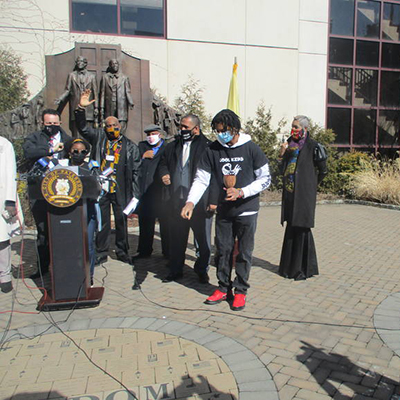By ED RUMLEY
PATERSON, NJ – The City of Paterson became the first municipality in New Jersey to proclaim February 28, recognized already as Amistad Day, an annual and official observance.
The event, held at Paterson’s Huntoon-VanRensalier Monument which honors Paterson’s place in the Underground Railroad, a passageway for slaves attempting to escape from bondage, was hosted by Mayor Andre Sayegh, Paterson Board of Education Commissioner Emmanuel Capers, and The Bugg Foundation.
Made possible by the 1841 landmark decision, the United States v. Schooner Amistad, heard by the U.S. Supreme Court, which freed kidnapped Mende people from West Africa’s Sierra Leone whom had been illegally sold into slavery and shipped by boat to Cuba to be resold, Amistad Day recognizes the efforts of the imprisoned passengers who organized a successful mutiny and the vessel eventually landed at Long Island. The court ruled in favor of the native Africans and addressed important national and international issues, as well as aiding the abolitionist anti-slavery movement.
The session was opened with a prayer of reconciliation by City Council Vice President Lilisa Mims.
“This place is where freedom happened, a stop on the Underground Railroad,” Sayegh stated, following the invocation. “What better place is there to celebrate Amistad Day as the first city in New Jersey to do so and declare it an annual observance?”
Led by Raheem Smallwood, the director of Paterson’s Silk City School Based Youth Services Program, Nasir Smallwood, a freshman at Bloomfield College, and International High School senior Janaeya Smith performed a ceremony in which a libation was poured and audience members were encouraged to raise up their right hands and form a fist, to signify a display of unity.
“We are pouring this water on sacred ground,” Smallwood stated. “Today we are here representing different countries and different organizations but we want to come together, collectively, as a whole. We must remember our ancestors who came before us. We stand on their shoulders. Their love, labor, and struggle for freedom laid the foundation on which we stand. We want to carry on and honor the strength and dignity of our brothers and sisters who have gone before us.”
Stephanie James Harris, Ph.D., the Executive Director of the New Jersey Amistad Commission, a division of the Department of Education, spoke at the commemoration about the “African Diaspora.”
“We stand in spaces like this where slaves escaped from states such as South Carolina, Delaware, and Kentucky, and came to Garrett Mountain,” Harris stated. “They would look at night for a signal from the light of a lantern.
“Observing Amistad Day is not only about African American History, or American History, but collaborative history.”
Harris said she would like to see African American curriculum, including the history of Amistad, included in all of the nearly 600 New Jersey school districts, an effort Capers has been at the forefront of, especially in Paterson.
Former Paterson Mayor Jeffery Jones told the audience that the dialogue was, “not just about persons of color but of the consciousness of a nation.” Jones said that despite recent state legislation requiring public schools to include African American history lessons, some have resisted doing so.
A self-professed daughter of a sharecropper Fourth Ward Councilwoman Ruby Cotton encouraged those in attendance to give honor to those who have come before us. “For without them, we would not be here,” Cotton concisely concluded.
Sayegh made special notice of the Bugg Foundation which was represented by Sharrieff Bugg who, with foundation volunteers, has worked tirelessly to combat stigma sometimes connected with those who suffer from mental illness.
On hand to help recognize the significance of the proceedings was Paterson historian Jimmy Richardson who summarized that the commemoration of the day was to “acknowledge that slavery and the Transatlantic Slave Trade were appalling tragedies in the history of humanity.”
“By proclamation, Paterson is yet again among the first in resistance, rebellion, human rights, labor, the early underground railroad, and the Civil Rights Movement, making this a year of African American descent.”
